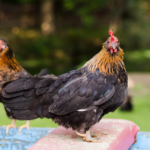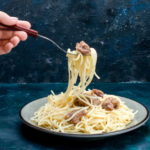The Polish chicken, also known as “Poland chicken” or “Top Hat chicken,” is one of the most distinctive and beloved breeds of poultry worldwide. Recognized by its extravagant feathered crest that gives it a regal, almost comical appearance, the Polish chicken stands out in any flock. Beyond its striking looks, it is a breed with a fascinating history, interesting characteristics, and a unique set of attributes that make it a favorite for both backyard chicken enthusiasts and show breeders alike. Whether you’re a seasoned poultry keeper or a curious newcomer, this comprehensive guide will give you an in-depth look at everything there is to know about the Polish chicken.
1. History and Origins of the Polish Chicken
The history of the Polish chicken is somewhat mysterious, with no definitive records to pinpoint its exact origin. Despite its name, the breed does not appear to have originated from Poland. Instead, historical records suggest that Polish chickens were first developed in the Netherlands. Some believe that the name “Polish” comes from the bird’s resemblance to the feathered caps worn by Polish soldiers in the 16th century, while others argue that the name is derived from the old Dutch word “pol” which means “head,” referring to the chicken’s distinctive crest.
The Polish chicken gained popularity across Europe during the Middle Ages, and by the 16th and 17th centuries, it was one of the most highly prized breeds for its beauty and egg-laying abilities. By the 1800s, Polish chickens had made their way to England and the United States, where they continued to be favored for their unusual appearance and versatility.
Today, the Polish chicken is recognized by poultry associations around the world, including the American Poultry Association (APA) and the Poultry Club of Great Britain. Despite its historical role as an egg-layer, the breed is now more commonly kept for ornamental purposes, exhibitions, and as pets due to its distinctive look and gentle personality.
2. Characteristics and Appearance
a. Physical Traits
The most defining feature of the Polish chicken is its crest, or “top hat,” a dramatic puff of feathers that adorns the top of its head. This crest is a result of the bird’s unique skull structure, which features a rounded protrusion that supports the plume of feathers. The size and fullness of the crest can vary, but in show-quality birds, it is often large and spherical, sometimes completely covering the bird’s eyes.
Polish chickens come in both standard and bantam sizes, with bantams being miniature versions of the breed. The average weight of a standard Polish hen ranges from 4 to 5 pounds, while roosters can weigh between 5 and 6 pounds. Bantam Polish chickens are much smaller, typically weighing around 1 to 2 pounds.
b. Plumage and Color Varieties
Another standout feature of the Polish chicken is its striking plumage, which comes in a wide variety of colors and patterns. The American Poultry Association recognizes several different color varieties of Polish chickens, including:
- White Crested Black: The most iconic variety, featuring black feathers on the body with a contrasting white crest.
- Golden: A rich golden-brown body with black lacing on the feathers.
- Silver: Similar to the Golden variety but with silver and white coloring instead of gold.
- Buff Laced: Creamy buff feathers with white lacing, giving the bird a delicate, pastel appearance.
- White: Pure white feathers covering the entire body and crest.
- Blue: Soft blue-gray feathers, sometimes with darker lacing around the edges.
In addition to these standard varieties, there are several other color mutations and non-standard patterns that breeders may produce.
c. Crest and Beards
Polish chickens can be either “bearded” or “non-bearded.” Bearded Polish chickens have additional tufts of feathers around their face and neck, giving them a fuller, fluffier appearance. Non-bearded varieties lack these extra feathers and have a more streamlined look. Both bearded and non-bearded Polish chickens are recognized by poultry associations, but the bearded variety tends to be more popular in show circuits due to its ornate appearance.
3. Temperament and Behavior
Polish chickens are known for their friendly and curious nature, making them a popular choice for backyard flocks and as pets. They are generally docile and non-aggressive, which makes them well-suited for families with children or other animals. However, their unique crest can sometimes limit their vision, which may make them more skittish or nervous, especially in unfamiliar environments.
Due to their limited vision, Polish chickens are more vulnerable to predators than other breeds, as they may not see threats coming until it’s too late. As a result, they require extra care and protection, particularly if they are free-ranging.
One interesting aspect of the Polish chicken’s temperament is its relatively quiet demeanor. Unlike some breeds that can be loud and boisterous, Polish chickens are typically calmer and less vocal, which makes them a good choice for urban or suburban settings where noise might be an issue.
a. Social Behavior
Polish chickens are social creatures and generally do well in mixed flocks. However, because of their unique appearance, they may be more prone to bullying from other, more aggressive breeds. Chickens tend to peck at anything that looks different, and the large crest of the Polish chicken can be an easy target. If keeping Polish chickens with other breeds, it’s important to monitor their behavior and ensure that they are not being harassed or injured by other birds.
b. Personality Quirks
Despite their gentle nature, Polish chickens can sometimes be a bit eccentric. Their limited vision means they may startle easily, and they often exhibit curious and quirky behaviors, such as pecking at shiny objects or exploring their surroundings with more enthusiasm than other breeds. Their playful and inquisitive personalities can make them a joy to watch, and many owners find that their Polish chickens have distinct, individual personalities that set them apart from other chickens.
4. Egg Production
While Polish chickens are primarily kept for ornamental purposes today, they were historically valued for their egg-laying abilities. Polish hens can still produce a respectable number of eggs, though they are not considered prolific layers compared to some of the more dedicated egg-laying breeds like the Leghorn.
On average, a Polish hen will lay around 150 to 200 small to medium-sized white eggs per year. This translates to approximately three to four eggs per week, depending on the individual bird and environmental factors such as diet, daylight hours, and temperature.
Polish chickens are not known for being broody, meaning they are less likely to sit on and hatch their eggs. This can be a benefit for owners who are more interested in egg production than raising chicks, as non-broody hens will continue to lay eggs without taking time off to incubate them.
5. Care and Maintenance
Polish chickens require the same basic care as any other chicken breed, but there are a few special considerations due to their unique features. Here are some important aspects of Polish chicken care:
a. Coop and Run
Because Polish chickens are more vulnerable to predators due to their limited vision, it’s essential to provide them with a secure coop and run. Their enclosure should be predator-proof, with sturdy fencing and a covered top to protect them from aerial predators like hawks or owls. If free-ranging is desired, supervision is recommended to ensure their safety.
Inside the coop, Polish chickens need the same basic amenities as other chickens: clean bedding, roosting bars, nesting boxes, and access to fresh water and food. However, because their large crests can collect dirt and debris, it’s important to keep the coop and surrounding area as clean as possible to avoid infections or feather matting.
b. Feeding
Polish chickens do not have any special dietary requirements beyond what is recommended for all chickens. A balanced commercial layer feed that provides the necessary nutrients for egg production and overall health is suitable for Polish hens. In addition, offering grit and calcium supplements (such as crushed oyster shells) can help with digestion and eggshell quality.
c. Crest Maintenance
One unique aspect of caring for Polish chickens is crest maintenance. The large feathered crest on their head can become dirty, matted, or infected if not properly maintained. Regular checks for parasites, such as lice and mites, are important, as these pests can easily hide in the dense feathers of the crest. Additionally, some owners choose to trim the feathers around the eyes to improve the chicken’s vision and reduce the chances of injury or anxiety.
During wet or muddy weather, Polish chickens’ crests can become soaked, leading to discomfort and potential health issues. In these cases, owners may need to gently clean and dry the crest to keep the bird comfortable.
d. Health Considerations
Polish chickens are generally hardy birds, but they are prone to a few specific health issues due to their unique anatomy. One common problem is “crooked beak,” a condition where the bird’s beak becomes misaligned, making it difficult for them to eat. This can be managed with careful trimming and monitoring.
Their large crests can also lead to vision problems, which may result in behavioral changes such as increased skittishness or anxiety. Regular crest maintenance and trimming can help alleviate these issues.
6. Polish Chickens in Poultry Shows
Polish chickens are a popular breed for poultry exhibitions due to their striking appearance and unique characteristics. Show-quality Polish chickens are bred for specific traits, such as a full, symmetrical crest, vibrant plumage, and a well-proportioned body. Judges at poultry shows evaluate birds based on these and other criteria outlined in breed standards, such as the American Poultry Association’s Standard of Perfection.
Breeders who wish to show Polish chickens often put extra effort into grooming and training their birds. This includes regular handling to ensure the chicken is comfortable being touched by judges and routine crest maintenance to keep feathers clean and well-groomed.
Polish chickens are one of the more challenging breeds to raise for show, as their feathers can be easily damaged, and their crests require constant attention. However, the reward of seeing a beautifully groomed Polish chicken take the top prize at a show makes the effort worthwhile for many enthusiasts.
7. The Appeal of Polish Chickens as Pets
In addition to their popularity as show birds, Polish chickens have gained a following as pets. Their friendly and quirky personalities, combined with their unique appearance, make them an excellent choice for families looking for a backyard pet. Polish chickens are often described as gentle and affectionate, and they can form strong bonds with their human caretakers.
Their smaller size, particularly in the bantam variety, makes them easier to handle than some larger breeds, and their relatively calm nature means they are less likely to cause problems in a backyard flock.
a. Ideal Environment for Polish Chickens
Polish chickens do best in a calm and secure environment where they can explore and interact with their surroundings without being harassed by other birds or predators. While they can be kept in mixed flocks, they tend to thrive when housed with other non-aggressive, ornamental breeds that won’t bully or pick at their crests.
b. Training and Interaction
Many owners find that Polish chickens enjoy human interaction and can be trained to come when called, eat from their hands, and even tolerate being held or petted. With regular handling from a young age, Polish chickens can become quite tame and friendly, making them a delightful addition to any backyard.
Conclusion
Polish chickens are a fascinating and beautiful breed with a rich history and a wide range of appealing traits. Whether you’re interested in raising them for their ornamental value, showing them at poultry exhibitions, or simply enjoying their quirky personalities as pets, Polish chickens offer something for everyone. Their unique appearance, friendly nature, and manageable size make them a favorite among chicken enthusiasts worldwide. With proper care, attention, and a little bit of grooming, Polish chickens can thrive in a variety of settings, providing both eggs and companionship for years to come.







